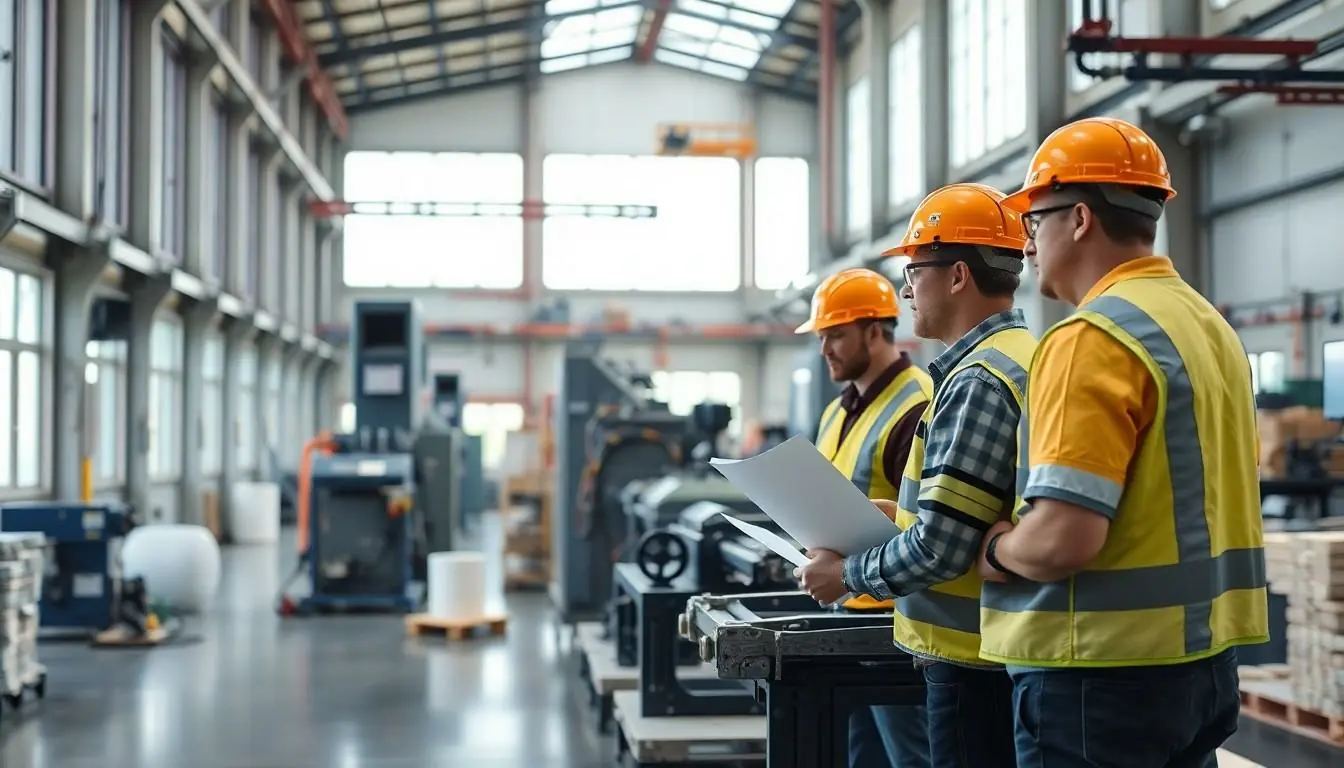Table of Contents
ToggleIn a world where Mother Nature sometimes feels like a cranky roommate, sustainable manufacturing technology steps in as the peacekeeper. Imagine a factory that not only churns out products but also gives a high-five to the environment. It’s not just a dream; it’s happening right now. Companies are trading in their traditional methods for greener alternatives, proving that being eco-friendly doesn’t mean sacrificing quality or profit.
Sustainable manufacturing technology isn’t just a trend; it’s a revolution. Businesses are discovering that going green can boost their bottom line while keeping the planet happy. From energy-efficient machinery to waste reduction techniques, the future of manufacturing is bright—and not just because of all those LED lights! Join the movement and see how innovation can lead to a cleaner, greener tomorrow.
Overview of Sustainable Manufacturing Technology
Sustainable manufacturing technology represents a major shift in production practices. Companies strive for methods that minimize environmental impact while maintaining efficiency and profitability. Innovations such as energy-efficient machinery play a crucial role in reducing energy consumption. Additionally, waste reduction techniques capitalize on resource conservation.
Adoption of renewable energy sources is becoming increasingly common. Solar panels and wind turbines often supply power, allowing facilities to operate sustainably. Moreover, sustainable materials are now favored in production processes. Biodegradable and recycled materials contribute to lowering the carbon footprint.
Manufacturers utilize advanced analytics and smart technologies for process optimization. This data-driven approach leads to enhanced resource allocation and less waste. Industry 4.0, defined by automation and the Internet of Things, also supports these goals. Connectivity among devices fosters real-time monitoring and decision-making.
Regulatory pressures and consumer demand drive the transition towards sustainability. Governments implement stricter environmental regulations, prompting companies to comply with new standards. Consumers express preference for eco-friendly products, influencing manufacturers to adopt sustainable practices.
Overall, sustainable manufacturing technology integrates environmental stewardship into business strategy. This reality leads to cost savings and improved brand reputation. Ultimately, companies embracing these practices contribute to a greener, more sustainable future.
Key Principles of Sustainable Manufacturing

Sustainable manufacturing incorporates various principles to minimize environmental impact and maintain efficiency. Two critical aspects include resource efficiency and waste reduction.
Resource Efficiency
Resource efficiency focuses on maximizing the utility of materials, energy, and water throughout the manufacturing process. Companies adopt energy-efficient machinery to optimize operations, reducing energy consumption significantly. Techniques like lean manufacturing streamline processes, ensuring the efficient use of raw materials while curtailing waste. By utilizing sustainable materials, businesses lower their carbon footprint and minimize reliance on non-renewable resources. Implementing advanced analytics assists in identifying areas for improvement, resulting in better resource allocation and higher overall productivity. Enhanced resource efficiency not only conserves raw materials but also contributes to cost savings and enhanced profit margins.
Waste Reduction
Waste reduction plays a crucial role in sustainable manufacturing by minimizing the quantity of waste produced during production. Companies implement strategies such as recycling, reusing, and remanufacturing materials to reduce disposal needs. Techniques like Just-in-Time inventory enable businesses to achieve lower waste levels by aligning production closely with demand. Incorporating waste audits helps identify sources of waste, enabling targeted interventions. Additionally, adopting circular economy principles encourages manufacturers to design products with end-of-life considerations in mind, thus promoting reuse and recycling. Through these strategies, waste reduction enhances environmental performance and fosters a culture of sustainability within organizations.
Innovations in Sustainable Manufacturing Technology
Sustainable manufacturing technology continues to evolve, showcasing innovations that reduce environmental impact. Companies increasingly adopt advanced practices, driving efficiency and sustainability.
Renewable Energy Sources
Adopting renewable energy sources like solar panels and wind turbines becomes essential for manufacturing facilities. Each energy system plays a crucial role in decreasing reliance on fossil fuels. Many manufacturers now use solar power not only to operate machinery but also to power entire production lines. Wind energy contributes significantly, especially in regions with favorable conditions. Transitioning to these sources minimizes greenhouse gas emissions, underscoring a commitment to sustainability. The integration of battery storage solutions further enhances reliability, allowing energy use balance during peak demand periods.
Advanced Materials
Utilizing advanced materials transforms manufacturing processes by promoting sustainability. Innovations in biodegradable materials, for instance, significantly decrease waste in landfills. Manufacturers increasingly utilize recycled materials, reducing the need for virgin resources while cutting down on energy consumption. In addition, composite materials offer lightweight alternatives that enhance product efficiency and durability. Research into smart materials also emerges, allowing products to adapt to environmental conditions, thereby extending their lifespan. Through these advancements, manufacturers enhance their environmental stewardship and improve overall product performance.
Challenges in Implementing Sustainable Manufacturing
Implementing sustainable manufacturing faces various challenges that hinder its widespread adoption and effectiveness. Understanding these constraints is crucial for navigating the transition toward eco-friendly practices.
Economic Barriers
Economic barriers often pose significant obstacles. High initial investment costs for sustainable technologies can deter manufacturers from making the switch. Companies may struggle to justify the long-term savings with immediate expenses. Additionally, fluctuating market conditions can complicate financial planning, making it difficult to secure funding for sustainable initiatives. Economic incentives, such as government subsidies or tax breaks, sometimes provide relief, but not all regions offer these benefits. Capital constraints frequently restrict small and medium-sized enterprises from adopting advanced sustainable practices.
Technological Limitations
Technological limitations also impact the transition to sustainable manufacturing. Lack of access to cutting-edge technologies can hinder progress. Many companies rely on outdated machinery that is not conducive to eco-friendly practices. Integration of new technologies into existing production lines can pose logistical challenges, requiring extensive training and adaptations in workflow. Research and development efforts may face funding shortages, slowing down innovation in sustainable technologies. Moreover, interoperability between new and old systems often creates complications that can delay implementation. Addressing these limitations is essential for businesses to successfully adopt sustainable manufacturing practices.
Future Trends in Sustainable Manufacturing Technology
Emerging technologies promise vast advancements in sustainable manufacturing. Companies are increasingly leveraging artificial intelligence for predictive analytics, which enhances operational efficiency. The integration of the Internet of Things (IoT) enables real-time monitoring of resources, allowing manufacturers to optimize energy consumption.
Blockchain technology is gaining traction, providing transparency in supply chains and ensuring the ethical sourcing of materials. This increased visibility strengthens consumer trust and encourages responsible practices. Additionally, 3D printing continues to revolutionize production processes by minimizing waste and enabling decentralized manufacturing.
Innovations in materials science are noteworthy, with the development of bio-based materials that replace traditional plastics. Such materials contribute to reduced environmental footprints and can enhance product performance. Furthermore, the adoption of automation in manufacturing processes improves precision and reduces human error, leading to significant waste reductions.
Collaboration among companies, research institutions, and governments is essential for advancing sustainable practices. Joint ventures can lead to shared knowledge and resources, accelerating the implementation of green technologies. The focus on circular economy models is expanding, encouraging manufacturers to design for durability, reuse, and recyclability.
In response to growing consumer demand for sustainability, brands that prioritize eco-friendly initiatives gain a competitive edge. Investments in renewable energy sources like solar and wind power are becoming standard, as companies strive to achieve net-zero emissions. Companies remain committed to sustainability, integrating it into their core operations to enhance overall business resilience and long-term viability.
Sustainable manufacturing technology is reshaping the industry landscape by marrying environmental responsibility with business efficiency. As companies embrace innovative practices and renewable resources, they not only enhance their operational performance but also contribute to a healthier planet. The integration of advanced technologies and circular economy principles paves the way for a sustainable future, where waste is minimized and resources are utilized efficiently.
With growing consumer demand for eco-friendly products and increasing regulatory pressures, manufacturers are compelled to adapt. This shift towards sustainability isn’t just beneficial for the environment; it also offers a competitive advantage in today’s market. By prioritizing sustainable practices, businesses can thrive while making a positive impact on the world around them.






